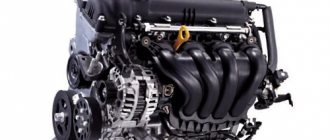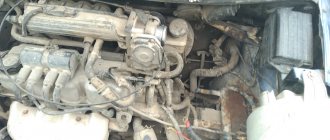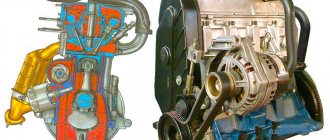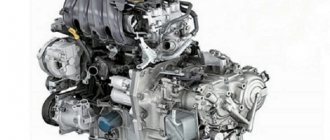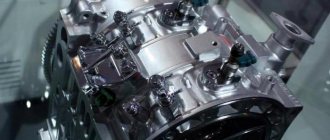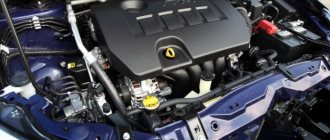Back in 2000, the Kia Rio was born to replace the already outdated Kia Avella, which was not distinguished by high reliability or quality. Kia lovers needed a car to travel around the city. For this reason, manufacturers released Rio, so as not to let down customers around the world.
First of all, the presentation took place in Geneva and Chicago, where a sedan and a hatchback were presented to the audience. Rio was distinguished by a modern design, a comfortable interior and a number of trim levels, which had the optimal quality-to-price ratio for that time, which captivated the public.
The second generation, produced in 2005, fully met European standards. In accordance with this, the price has also increased. Produced for five years (2006, 2007, 2008, 2009, 2010). A version was supplied to Russia in which the engine capacity was 1.4 liters, but a choice was given: manual or automatic.
The third generation, produced in 2011, remains relevant to this day. The new version of Kia was intended for sale in Europe. The Rio version for Russian residents was presented in Moscow in August of the same year, but left the assembly line in St. Petersburg. Since 2012, in addition to the sedan, the Kia Rio hatchback began to be produced.
Kia Rio engine characteristics
In 2013, a sedan and a hatchback were also released, which differed only in body shape and weight. The Kia Rio sedan turned out to be 100 kg heavier. For Russian drivers, Rio was distinguished by characteristics specially selected for our roads.
Namely:
- Engine running on AI-92 gasoline.
- Anti-corrosion coating for the underbody.
- Possibility of starting at temperatures down to -35°C.
- The radiator is treated with a special protective compound, which is appropriate on winter roads covered with salt.
Characteristics of the 2012 hatchback and sedan:
- Gasoline with an octane number of 92 or more.
- Fuel tank volume - 43 l.
- Weight of Kia Rio hatchback and sedan - 1565 kg.
- Ground clearance is 160 mm.
- Trunk volume: hatchback - 389 l, sedan - 500 l.
- Dimensions: hatchback - length 4120 mm, width 1700 mm, height 1470 mm, sedan - length 4370 mm, width 1700 mm, height 1470 mm.
Both in Russia and in other countries, Kia Rio ranks first in sales. In 2014 he took 3rd place. In just 4 years, Russians purchased about 300,000 of these cars. The new Kia Rio was born in 2020 and was distinguished by the appearance of the interior and body.
Interesting! Kia Rio owners can choose which engine their car can be equipped with: a volume of 1.4 liters and a power of 107 horsepower, or a volume of 1.6 liters and a power of 123 horsepower.
Each of the engines has one of the gearboxes in accordance with the configuration: 5 manual transmissions, 4 automatic transmissions, 6 manual transmissions or 6 automatic transmissions. The engines, both one and the other, run on gasoline.
Accordingly, its future characteristics will depend on the choice of engine. Such as acceleration speed, maximum speed and fuel consumption.
Main engine components
- Long M12 spark plugs with increased cooling efficiency.
Ignition coils
Electronic throttle control system, which is installed on the intake manifold. The system controls the opening angle of the damper using a drive motor. To increase the reliability of the system, a contactless connection is used.
Aluminum cylinder block.
Oil pump
A design offset of 10mm between the crankshaft center and the cylinder center is applied to reduce friction. Friction is reduced by reducing the lateral force acting on the cylinder wall. In addition, noise is reduced at low engine speeds.
Valve train chain.
CVVT (Continuously Variable Valve Timing) system.
MLA valve system.
14.06.2017
When preparing to buy a Kia Sid, many people wonder which engine to choose. Indeed, the range of engines for this car offers four units that differ significantly from each other. There are differences in volume, fuel injection technology, the presence of turbocharging, and so on. Its most important characteristics will depend on which unit will be installed on the car:
- Dynamism;
- Fuel consumption;
- Price.
Kia Ceed GT-line
And this is not to mention reliability, driving confidence, maintainability and cost of ownership. We will try to understand the main technical points, strengths and weaknesses of Sid engines and explain which one is better and for what conditions.
Features and characteristics for the Kia Rio 1.4 engine
The third generation Rio engine, having a displacement of 1.4, is the base engine and produces 107 horsepower, 6300 rpm. Which is quite a lot for such a volume, considering that the engine runs on 92-octane gasoline. The manual transmission provides acceleration to 100 km/h in 11.5 seconds.
Fuel consumption of 1.4-liter engine:
- In the city - 7.6 liters.
- On the highway - 4.9 liters.
- In the combined cycle - 5.9 liters.
Dynamics:
- Engine capacity – 1396 cm3.
- Cylinder diameter – 77 mm.
- The piston stroke is 75 mm.
- Number of cylinders/valves – 4/16.
- Maximum speed is 190 kilometers per hour.
How to read Hyundai engine markings
The marking procedure for Korean Hyundai engines is uniform. For example, consider the engine markings from a Hyundai Solaris car. The brand of motors is designated by a set of English letters and numbers. The first four elements represent the main engine markings that have meaning:
- letter—engine type, “G”—gasoline (“D”—diesel);
- number - number of cylinders;
- letter - motor generation, in this case F - Gamma;
- letter - engine volume (letter “A” 1.4 l).
Additional markings begin with the fifth character and contain, as above, a numerical and alphabetic set.
5. a number or letter indicates the year of manufacture, up to 2010 a number, including 2010 and after - in Latin letters; 6. letter or number - country of engine manufacturer and city in which the plant is located;
The following numbers are the serial number of the motor. To determine the places of engine manufacture, I will give their designations in the markings:
| Designation of places of manufacture of Hyundai engines |
| South Korea |
| Montgomery |
| Slovakia |
Long markings are indicated only in the vehicle documentation, and on Hyundai
Basically they knock out four-digit markings. The places where it is applied can be different; this is built into the design of a particular model. The main thing is that this is a clearly visible place on the cylinder block. Production started in 2007.
Features and characteristics for the Kia Rio 1.6 engine
Kia Rio with this engine modification is a very popular car in our country. Owners are undoubtedly attracted by the comfort and acceleration of the model. Despite some disadvantages, there are still more advantages, which attracts drivers.
The engine, having such a small volume, has good power ratings of 123 horsepower, which contributes to comfortable driving on the highway outside the city and a feeling of confidence.
Important! For this type, it is recommended to use 95 gasoline. The endurance and reliability of the engine is ensured by the chain as a timing drive.
One of the disadvantages is increased noise and harsh driving. The belt ensures silence in the cabin. The risk of chain breakage is reduced to zero, but just like a belt, it requires replacement.
An engine making accompanying noise will give the driver a sign that it is time to change it. There is also a problem that cannot be fixed. In Kia Rio, vibration is often observed when the tachometer needle reaches medium speed, closer to 3,000. This is a factory malfunction of all Kia Rios. A resonance occurs that does not lead to a negative outcome.
Kia manufacturers promise a chain life of up to 200,000 kilometers.
Fuel consumption of the 1.6-liter Kia Rio engine:
- In the city - 8 liters.
- On the highway - 5 liters.
- In the combined cycle - 6.6 liters.
Dynamics:
- Engine capacity - 1591 cm3.
- Cylinder diameter – 77 mm.
- Piston stroke – 85.4 mm.
- Number of cylinders/valves – 4/16.
- Maximum speed is 190 kilometers per hour.
Judging by the reviews of Rio car owners, fuel consumption in the city is much higher, which is another disadvantage. Despite this, most Kia drivers still prefer cars with this engine size.
How to take care of your engine
Since engine repair is usually an expensive process and, most often, once started, endless, then following a couple of simple rules will save you from unnecessary fuss. Engine protection and care is: high-quality fuel, properly selected oil and antifreeze, not water. The last thing you need to remember!
About the oil
To achieve maximum acceptable performance and adequate engine protection for your KIA RIO, select only an oil that will meet ILSAC or API requirements. Those lubricants whose viscosity coefficient does not have the proper SAE grade should not be used.
In general, KIA officially fills its engines with Hyundai OIL Bank, SK Lubricants, S-Oil oil and a couple of other lubricants. In terms of specificity, they are like twin brothers to the Ilsakov GF-3/4/5. They all have analogues of the 5w-20 brand.
Changing the oil and filter
Naturally, the first thing to do is drain the old oil, and to do this:
- a protection
(cover) on the oil drain neck - Pull out the drain plug and drain the oil, but not onto the ground, but into some container.
Next, the filter is replaced:
- Remove the oil filter;
- Inspect and clean its mounting surface. Check for defects;
- Make sure the new filter is identical to the one you are replacing;
- Apply new oil to the gasket of the new filter element;
- Once in place, twist it lightly until the new gasket contacts the seat.
- Tighten all the way.
And finally, changing the oil:
- Install the cleaned hole plug with a new gasket;
- Refill with fresh engine oil. It should not be filled to a level higher than mark F.
According to the Kia Rio manuals 1.4 and 1.6, an oil change should occur almost every 7,500 km. And despite the fact that they often write things that are completely far from reality, it is better for a complete oil change to occur rather than adding it a little at a time. Well, the fact that the oil filter needs to be changed every time the oil is changed is probably known to the average service station worker.
How to protect the motor from constant temperature changes
It’s bad that Koreans don’t live and build their cars here. This is probably why car owners have to think on their own about how to protect their cars from overheating and freezing. The maximum -5° in Korea and ours - 25° are significantly different.
Of course, in both Kia Rio 1.4 and 1.6 engines the thermostats were replaced, but, unfortunately, this does not solve the problems. Even a triple thermostat is not protection from our frosts. That's why you have to warm up the car for 15 minutes every morning before starting it.
While browsing various websites and forums on automotive topics, I came across one interesting idea: a means of insulating internal combustion engines. In simple terms - a blanket for the engine. I immediately remembered the old woolen blankets that my grandfathers used to protect their little ones from freezing. But here everything is a little more solid.
It is reasonable to use such a thermal insulation product for several reasons:
- The insulation prevents freezing of the mechanism elements of the Gamma 4 and 1.6 engines, which makes it possible to start at very low temperatures;
- A car blanket is a replacement for the need to frequently warm up the car.
The latter, by the way, also simultaneously solves two problems: it also saves fuel consumption, that is, protects
personal wallet, and precious time.
Total engine life of Kia Rio
Modern cars consist of a complex system of mechanisms and units controlled by electronics. You need to understand that the operating life of the mechanism is limited and Rio is no exception. New Kia Rio models have a Chinese engine.
The service life of such a Rio engine reaches 150,000-250,000 kilometers. This is due to the load on the motor and other related factors. Therefore, approaching these marks, owners need to be more careful and attentive to their cars and carry out maintenance.
Interesting! Basically, the service life of the Kia Rio engine includes a mileage of 100-150 thousand km.
300 thousand km. - approaching this figure indicates that it is time to repair the sixteen-cylinder engine. The four-cylinder device installed on the Kia Rio needs more frequent repairs. Kia also has a powerful eight-cylinder engine in its production, the service life of which reaches nearly a million kilometers.
If you purchased a used Kia car, its service life is reduced several times.
How did you achieve such results?
Thanks to several design features that distinguish the new Kia Rio device, manufacturers were able to not only improve engine performance, but also introduced several fundamentally new solutions to the concept of engine building. Some of them:
- We increased the volume of the cooling jacket, which made it possible to reduce the temperature of the exhaust gases, and this is additional protection;
- Thanks to better cooling of the spark plugs, the ignition timing has been increased, which significantly saves fuel;
- The axis between the center of the cylinder and the crankshaft has been shifted by 10 mm, which reduces friction and increases durability.
But that's not all. The fact is that the design of the third generation Kia Rio engine is fundamentally different from the engines that were in the second generation cars. And comparing them, of course, is just as incorrect as comparing a good smartphone and some black and white candy bar. But how nice it is!
Let's compare the features that distinguish the Gamma engines from the old Alpha
What can I say, there were unexpectedly many of them. In principle, this is not surprising; the Chinese have always had their heads in the right direction. Let's see what they've come up with.
- If you pay attention to the location of the manifolds, then, unlike the previous Kia Rio engine model, the Chinese decided that the intake manifold with the catalyst should be at the rear, between the engine and the engine shield. The intake valve was placed at the front and therefore the air inlet is cooler. This means its density is higher, which allows more fuel to be supplied to the cylinder and, as a result, increase power;
- I was also pleased with the absence of a timing belt that always requires maintenance. A good replacement has taken place, now instead of it the Kia Rio has a chain drive hidden in a block, which is regulated by two hydraulic tensioners;
- If we compare the 1.4 Alpha series engine with the 1.4 Gamma engine, then the locations of the mounted units have changed for the latter. The generator, for example, has moved upward, which reduces the risk of flooding. The air conditioning compressor is now in front, and the power steering pump is behind. In principle, the same changes are observed on Gamma 6;
- The intake manifold is plastic, with a small box on the intake pipe - it is a resonator, it reduces intake pulsation and noise level;
- The drive mechanism of all 16 valves was replaced - it lost hydraulic compensation, but this only benefited it. Since now there is no need to adjust the gaps between them.
In addition to all this, the operating mode of the generator has been improved. During acceleration, the power will be reduced so as not to force the engine, taking it away from it, and when braking, vice versa. To a certain extent, this even acts as protection of the engine from unnecessary overloads. At the same time, using the inertial motion of the vehicle to recharge the battery. In addition, installing a double thermostat in the cooling system will allow the engine to warm up more quickly.
How to extend engine life?
It is worth noting that with proper operation, the motor can operate without problems even if the service life is increased. Regular engine lubrication will extend the life of your Kia. Depending on the season, select the right synthetic oils for it. Refuel only with high-quality fuel at proven gas stations.
Using cheap gasoline or diesel fuel will quickly damage the engine. Savings can result in even greater costs later. Carry out preventive maintenance and oil changes on time, preferably every 5000-7000 kilometers, although Kia officials mention a figure of 15,000.
It is better to pay little by little to extend the work than to pay a large amount at once. The engine life is also affected by driving style; do not try to squeeze the maximum out of the car. These recommendations will help your unit last a long time and save money.
conclusions
As you can see, there are always pros and cons, even with such good engines as Gamma 1.6 and Gamma 1.4, so only time will tell how good this replacement was in the automotive player market. Everyone has their own preferences, but I like this machine.
Not really
KIA cars occupy first positions in the sales rankings of budget models. One of the most popular passenger cars called Rio has been in stable demand for many years. One of the reasons for this phenomenon is reliable engines. Many buyers choose the 1.6-liter power unit, to which we decided to devote a new article. Today you will learn the service life of this engine, its advantages and disadvantages, as well as recommendations from specialists for extending the service life of the unit.
Possible tuning of the engine installed on KIA
In order to increase engine power, you can resort to the following methods:
- Engine calibration. It is possible to increase power from the starting 140 to 150 horsepower. You should not try this method without a competent specialist.
- You can try installing a direct-flow exhaust (“Spider 4-2-1”) and adding shafts with a 268/264 phase or camshafts from a G4GM engine with a high valve lift, the volume of which is 1.8, then the engine power will increase to 160 horsepower .
- If finances allow, then camshafts with a 270 phase with a large lift can be made to order. You will have to weld the turbo manifold and ensure the oil supply to the turbine; the diameter of the exhaust pipe should be 53 or 61 millimeters. The following items will also be needed: 440c brand injectors, intercooler, piping. Power will increase significantly - up to 180 horsepower. How long this engine will last is another question.
Device
In general, the engine, by modern standards, is not too complex. The KIA Rio X Line 1.4 engine block is cast from aluminum with dry cast iron liners (thin-walled), which are poured in during the production process.
Fuel supply – MPI distributed injection with an injector, with a compression ratio of 10.5 units.
The engine has lightweight pistons and 2 camshafts. The design also provides for the presence of 2 phase shifters and an inlet pipeline with variable length. The timing drive is chain.
When creating this unit, the designers focused primarily on reducing weight and reducing fuel consumption, which they completely succeeded in doing.
Service regulations
Engine maintenance must be carried out with a mandatory visit to a service station. This is done every 15 thousand km. This order is due to the operation of the oil system, which requires periodic inspection, oil and filter replacement.
In addition to the standard program, there are scheduled maintenance designed for heavily loaded engines. So, if the internal combustion engine is operated at a temperature below 15 degrees. In this case, the maintenance schedule must be reduced to 7 thousand km.
It is interesting that the same engine is operated on one car under a higher load than on another. For example, Solaris and Kia Sid. Therefore, the same air filter on the first car must be changed every 15 thousand km, and on the Sid - every 45 thousand km. However, the cabin filter is updated at the same time - every 15 thousand km.
Read more about the inspection periods in the table.
| GDS drive chain | has a resource of 150 thousand km, after which replacement follows |
| oil and oil filter | change after 7.5 thousand mileage in the urban cycle or a maximum of 15 thousand in mixed use |
| fuel filter | fails at 20,000 km, and the air is replaced annually |
| spark plug | the service life is about 60 thousand mileage |
| antifreeze | loses properties after use for 3 years or 30 thousand mileage |
| crankcase ventilation | serviced after 30,000 km along with washing the engine with special decarbonizing agents |
